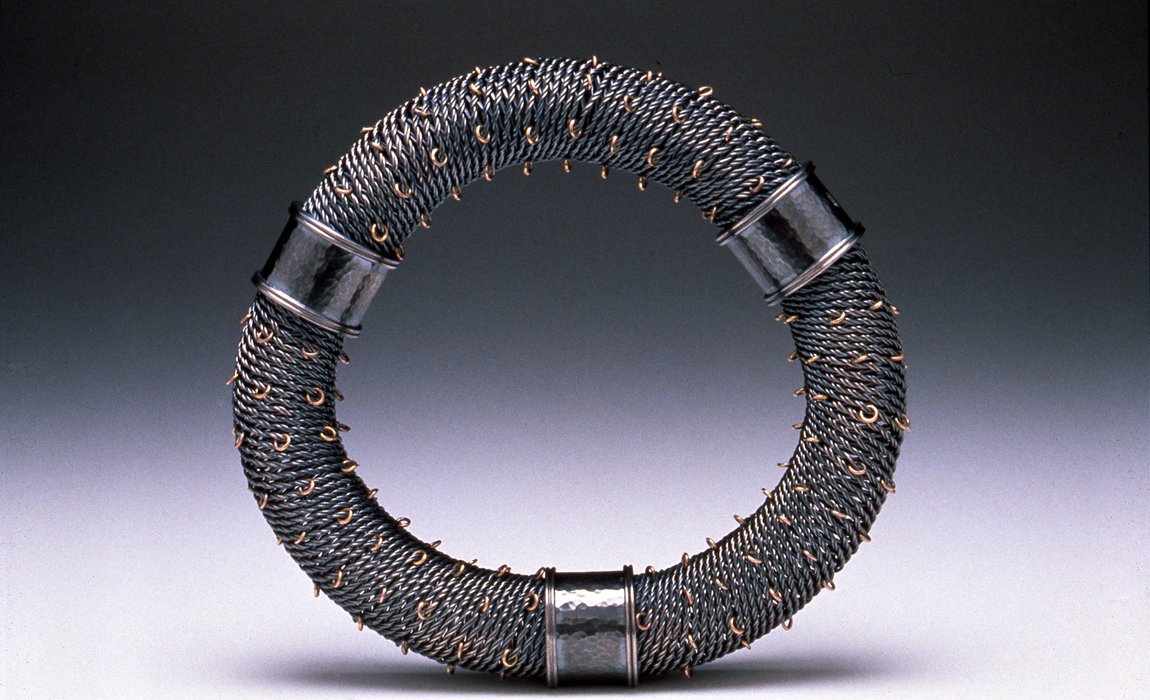Creativity: A Sense of Jewellery
The next three blog entries explore A Sense of Jewellery from the perspectives of creativity, craftsmanship and community. The Goldsmiths' Centre uses these words to highlight the principal values that underpin its work. Thinking about these values has catalysed this exhibition, since they are, arguably, all elements that need to come together to make a great piece of jewellery. This week I asked exhibition curators Amanda Game and Professor Dorothy Hogg MBE for their views on creativity.

Visiting an exhibition is one way to experience the creativity of others. I have just returned from the Joseph Cornell show 'Wanderlust' at the Royal Academy, where I was struck by the extraordinarily creative way he was able to cut and combine paper ephemera, to poetic effect. Wearing a piece of jewellery is another way to engage with creativity. With a necklace or ring the interaction can be very visceral; it becomes part of your body for the day. But identifying and experiencing the creativity of others is very different from being creative, so I started by asking Amanda and Dorothy what they think creativity is:
Amanda considers creativity to be a particular kind of thinking that draws together different forms of human intelligence: spatial, verbal, logical. Creative thought is “embodied thought that activates a way of looking at, and being in, the world”.
Dorothy is not keen to pin creativity down: “I am interested in trying not to define the intangible. A highly skilled Japanese musician of great age commands respect and is rewarded with the title ‘Holder of important intangible cultural properties’. I have a great respect for what is intangible in a creative process”.
Their answers suggest the complexity of creativity. The dictionary defines it as: “The use of imagination or original ideas to create something”. Struck by the reference to “original ideas”, I questioned whether something has to be new to be creative. Amanda considers this to be a misapprehension: “creativity and originality are achieved through being curious about the world, following an idea, working hard, and asking the right questions”.
So, turning to think about the works selected for A Sense of Jewellery, I asked what characteristics Amanda and Dorothy most value in an item of jewellery:
Dorothy is seeking: “an inspired integration of the idea with appropriate handling of materials”; a coming together of material knowledge, working in harmony with creativity and concept.

Amanda is looking for: “a work that makes you sufficiently curious that you want to pick it up”. She went on to say “you want a sense that someone has been aware of what others have done, that it is rooted in looking at other things”.
Amanda refers to Hans Stofer’s Moth Ring made in the 1990s, which is included in the exhibition. It is well made, functional, but unexpected. Its qualities as an object draw on an understanding of entomology and historical practices of display, as well as jewellery traditions. Its curious nature certainly makes me want to put it on, to experience wearing a portable vitrine; a modern twist on the Victorian language of collecting.
I concluded by asking how the works in A Sense of Jewellery represent creativity. Dorothy reflects that: “it has been a revelation to see how each piece in the exhibition represents a unique creative approach. This came home to me when I drew each piece to scale and then cut it out in order that Amanda and I could decide where each exhibit should be placed. A number of pieces, made primarily of wire, seemed to harmoniously and naturally sit together although they each represent a uniquely creative way of approaching the material”.

Talking about creativity led me to think how dependent creative practice is on a conducive environment. Just as Virginia Woolf’s proposes that “a woman must have money and a room of her own if she is to write fiction”, for the designer-maker there are certain conditions that will support and nurture their creative process. These are likely to include training and education, access to a making space, and opportunities for dialogue and interaction; the types of facility which the Goldsmiths’ Centre looks to provide. For each of the works that will be displayed in A Sense of Jewellery, the right conditions must have been in place to facilitate the creative impulse.
If you are wondering what Amanda and Dorothy are focusing on now, with five weeks to go until the exhibition opening, they are working closely with architectural practice Brocklehurst Architects Ltd (www.brocklehurst.com), to design the exhibition space at the Goldsmiths’ Centre. Amongst the challenges being faced are approaches to mounting the jewellery, to give as great a sense of the object as possible.
Should jewellery display and exhibition design interest you, do come along to hear leading architect Eva Jiricna CBE RA discusses her experience of working on the design of The William and Judith Bollinger Jewellery Gallery at the Victoria & Albert Museum in 2008, as part of the A Sense of Jewellery events programme, on the 29thOctober. Click here for more information and to book your ticket.